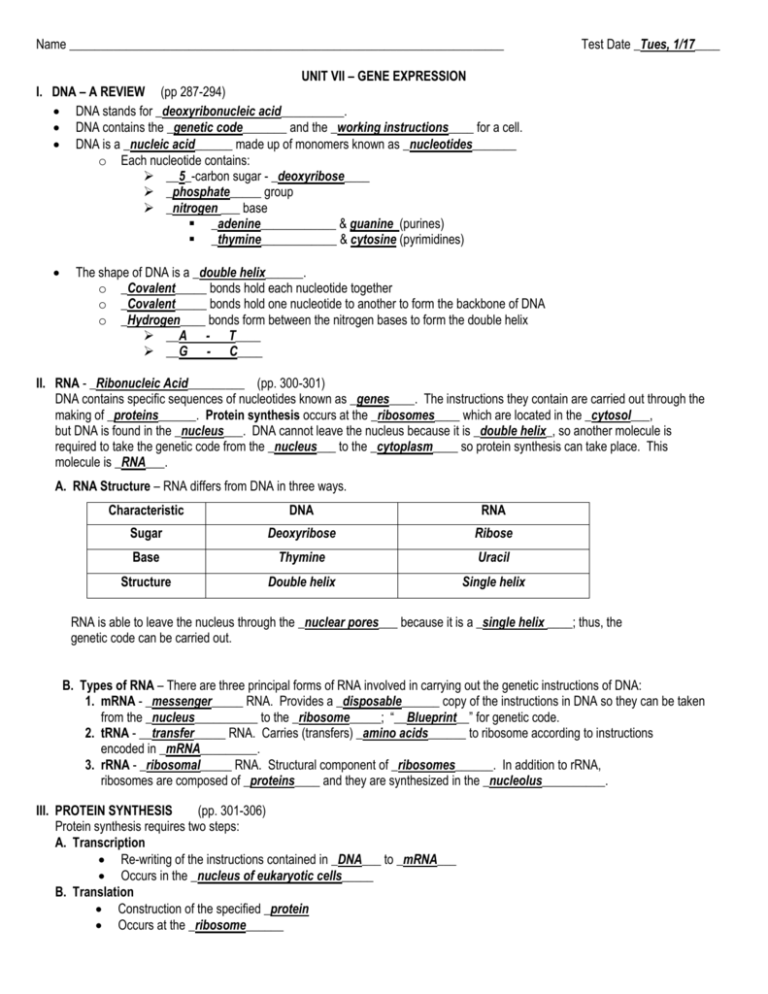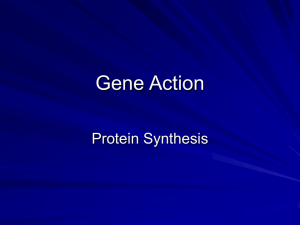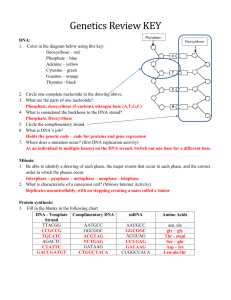unit vii – gene expression
advertisement

Name _____________________________________________________________________ Test Date _Tues, 1/17____ UNIT VII – GENE EXPRESSION I. DNA – A REVIEW (pp 287-294) DNA stands for _deoxyribonucleic acid__________. DNA contains the _genetic code_______ and the _working instructions____ for a cell. DNA is a _nucleic acid______ made up of monomers known as _nucleotides_______ o Each nucleotide contains: __5_-carbon sugar - _deoxyribose____ _phosphate_____ group _nitrogen ___ base _adenine____________ & guanine (purines) _thymine____________ & cytosine (pyrimidines) The shape of DNA is a _double helix______. o _Covalent_____ bonds hold each nucleotide together o _Covalent_____ bonds hold one nucleotide to another to form the backbone of DNA o _Hydrogen____ bonds form between the nitrogen bases to form the double helix __A - T____ __G - C____ II. RNA - _Ribonucleic Acid_________ (pp. 300-301) DNA contains specific sequences of nucleotides known as _genes____. The instructions they contain are carried out through the making of _proteins______. Protein synthesis occurs at the _ribosomes____ which are located in the _cytosol___, but DNA is found in the _nucleus___. DNA cannot leave the nucleus because it is _double helix_, so another molecule is required to take the genetic code from the _nucleus___ to the _cytoplasm____ so protein synthesis can take place. This molecule is _RNA___. A. RNA Structure – RNA differs from DNA in three ways. Characteristic DNA RNA Sugar Deoxyribose Ribose Base Thymine Uracil Structure Double helix Single helix RNA is able to leave the nucleus through the _nuclear pores___ because it is a _single helix ____; thus, the genetic code can be carried out. B. Types of RNA – There are three principal forms of RNA involved in carrying out the genetic instructions of DNA: 1. mRNA - _messenger_____ RNA. Provides a _disposable______ copy of the instructions in DNA so they can be taken from the _nucleus__________ to the _ribosome_____; “__Blueprint__” for genetic code. 2. tRNA - __transfer_____ RNA. Carries (transfers) _amino acids______ to ribosome according to instructions encoded in _mRNA_________. 3. rRNA - _ribosomal_____ RNA. Structural component of _ribosomes______. In addition to rRNA, ribosomes are composed of _proteins____ and they are synthesized in the _nucleolus__________. III. PROTEIN SYNTHESIS (pp. 301-306) Protein synthesis requires two steps: A. Transcription Re-writing of the instructions contained in _DNA___ to _mRNA___ Occurs in the _nucleus of eukaryotic cells_____ B. Translation Construction of the specified _protein Occurs at the _ribosome______ IV. TRANSCRIPTION First, the enzyme _RNA polymerase___________, unzips a specific portion of the DNA molecule by breaking the _hydrogen_____ bonds between the _nitrogen bases________. Specific sequences of DNA nucleotides known as the _promoter________ indicate the beginning of a _gene____ while the end of a gene is marked by a _termination____ sequence. RNA nucleotides are moved in _5’__ to _3’____, according to _base pairing rules____ and _mRNA___ is synthesized. There are several important ways that transcription differs from replication: Only _one side______ of the DNA molecule is copied in transcription while in replication, _both____ sides are copied. In RNA, the nucleotide that pairs with adenine is _uracil__. The nitrogen base, _thymine___, is not found in RNA. RNA polymerase does not require a _primer_____. In transcription, only _a portion of DNA representing one gene_____ is “unzipped” and copied; in replication, _the entire DNA molecule____ is unzipped & copied. In addition, in _replication__, all DNA molecules in a cell are unzipped & copied; this is not true in _transcription____. In a _eukaryotic____ cell, replication occurs during _S___ of the cell cycle while transcription primarily occurs during _G1_______. All cells carry out _transcription____; only cells that are _dividing____ carry out _replication____ In prokaryotic cells, as mRNA is transcribed, _translation___ begins virtually simultaneously. In eukaryotic cells, When the mRNA is transcribed, there are long sequences of _nucleotides______ that are not used for the synthesis of the protein. These non-coding nucleotides are known as _introns_____. The DNA sequences that actually code for the protein are known as _exons_________. Before mRNA exits the nucleus, the _introns_____ are edited (_cut__) out and the remaining _exons_____ are spliced together to form the final mRNA. mRNA leaves the nucleus via the _nuclear pores____ and travels to the _ribosome_____, the site of protein synthesis. V. TRANSLATION Translation takes place at the _ribosome____. The message in _mRNA_________ is read by the ribosome, _tRNA_____ brings the corresponding _amino acids_____ to make the final product – a _polypeptide____ chain, that eventually folds into a specific _conformation______ to form the _protein_____. A. Ribosomes Synthesized in the _nucleolus______ of eukaryotic cells Composed of _rRNA_____ and _protein___________________ Prokaryotic ribosomes are _smaller___ than eukaryotic ribosomes Composed of two __subunits_____ that come together when translation begins Two locations for eukaryotic ribosomes o Bound Attached to _rough endoplasmic reticulum__________________ Synthesize proteins _destined for export out of the cell_______ o Free Found suspended in the _cytosol_______________ Synthesize proteins _that will remain in the cell_________ B. Codons - A Mechanism to “Read” mRNA The monomers of proteins are _amino acids______. There are _20____ amino acids used in building the proteins essential for life yet there are only _4_____ different nucleotides DNA and RNA. In order to have a different code for each of the 20 amino acids, nucleotides are read in groups of _three__ known as _codons_____. The codons collectively make up the _genetic code____. The genetic code is _universal_______; in other words, a _codon___ codes for the same amino acid in all _organisms______. The genetic code is _redundant_______. Since there are __4__ possibilities for each nucleotide, and __3____ nucleotides represent a codon, this allows for _4__ x _4___ x _4__ = _64___ variations. There are only _20____ amino acids, so many different codons represent the same amino acid. There is one codon that designates “start” - _AUG____ which codes for _methionine (met)______. There are three “stop” codons: o _UAG______ o _UAA______ o _UGA______ For the following codons, identify the corresponding amino acid: a. UAC - ______________________________ b. AGA - ______________________________ c. GCA - ______________________________ d. CCU - ______________________________ For the following amino acids, give all possible codons: a. arginine - ______________________________________________ b. glycine - _______________________________________________ C. tRNA The function of tRNA is to transfer the _amino acid____ specified by the _mRNA codon_________ to the _ribosome_____ for protein synthesis. The _cytosol________ of every cell is stocked with all _20___ amino acids required for protein synthesis. tRNA forms _hydrogen__ bonds with itself, resulting in a folded molecule with an _amino acid___ at one end that is specific for that tRNA. At the other end, there is a group of three nucleotides known as the _anticodon________. The anticodon binds to the _mRNA codon____ according to _base pairing rules____. This insures that the proper amino acid is brought to the ribosome. D. The Steps of Translation mRNA joins with a _small___ subunit of a ribosome and the start codon, _AUG__, is read. The large subunit attaches to the complex forming a complete _ribosome_____. A tRNA carrying a _methionine__ arrives at the _A__ site of the ribosome. Base pairing occurs between the _tRNA anticodon__ and _mRNA codon__, insuring the proper amino acid has been delivered. The mRNA & ribosome slide against each other, moving the tRNA and its amino acid from the A site to the _P___ site. The next codon is read, and the tRNA with the corresponding _amino acid___ arrives at the _A__ site of the ribosome carrying its amino acid. The methionine that had been shifted to the P site forms a _covalent___ bond known as a _peptide___ bond with the next amino acid. Everything shifts _3__ places. The “empty” tRNA departs the ribosome, and the next codon is read. This process known as _elongation_____, results in a growing chain of amino acids known as a _polypeptide_______ chain. Elongation continues until a _stop__ codon is reached. At this point, the ribosome releases the _polypeptide____ chain, which coils and folds to form a _protein___. o The “empty” tRNAs will be re-charged by binding another amino acid. o The mRNA will be _degraded___ or translated again. o The protein may be modified, and used in the cell; for example, _enzymes_____, or packaged in a _vesicle___, sent to the _Golgi apparatus_____, and transported out of the cell via _exocytosis______. PROTEIN SYNTHESIS – A SUMMARY VI. MUTATIONS A mutation is a _change in the DNA sequence__________. Most mutations are harmful but they may also be _beneficial__ or _silent_. Mutations are classified according to the scope of the change: A. Chromosomal Mutations Involve the number or structure of the entire chromosome. Generally occur during _cell division____. Very serious consequences; usually results in death of cell. Types of chromosomal mutations: B. Gene Mutations Affect one gene on a chromosome Usually due to a mistake in _replication_____ Consequences are variable Known as point mutations; 2 main categories o Substitution One nucleotide is exchanged for another May or may not affect resulting amino acid sequence o Frameshift Caused by addition or deletion of nucleotide(s) Results in a different number of nucleotides, shifts the reading of the remainder of mRNA codons following mutation Typically more serious









